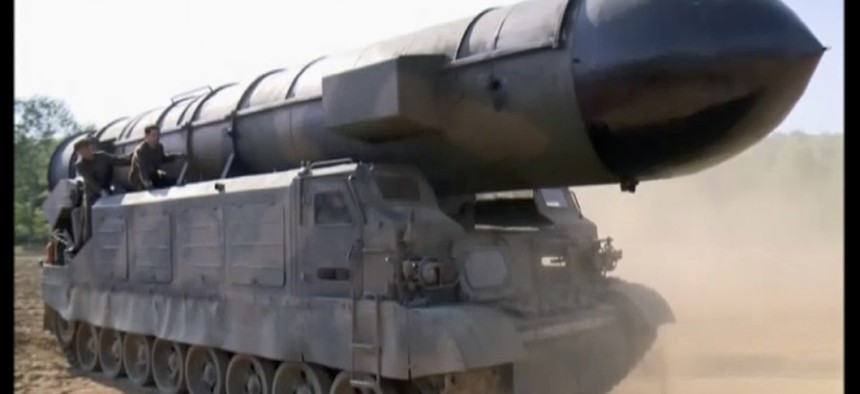Trump’s First Defense Budget Has North Korea Written All Over It

This image made from video of a news bulletin aired by North Korea's KRT on May 22, 2017, shows what was said to be the Pukguksong-2 missile at an undisclosed location in North Korea. KRT/AP
There’s lots of money in the Pentagon’s 2018 spending proposal to stop missiles of the sort that Pyongyang keeps launching.
Donald Trump’s first defense-budget request contains large increases for weapons intended to shoot down North Korean missiles or even attack them on their launchers. The budget bumps aren’t unexpected—many appeared in the outgoing Obama administration’s final spending plans as well. Still, they reveal the Pentagon’s intensifying focus on Pyongyang’s missile threat.
Here are a few of the most important adds:
Missile Defense from Alaska
The president requests $821 million for the Ground-based Midcourse Defense program. Midcourse defenses hit an incoming missile after its engine has shut down and before it gets too close to its target. The Missile Defense Agency is adding four Ground Based Interceptor, or GBI, missiles at Fort Greely, Alaska, bringing the total to 44 by year’s end. (There are also four GBIs in California.)
This year’s $821 million request, follows a plan announced by Defense Secretary Chuck Hagel in 2013, (that’s one reason why this year’s number is down from last year’s for the same program. Last year’s ask was about $1 billion.) But the program takes on new relevance because of North Korea’s quickening progress toward an operational ICBM. MDA says the extra missiles will “improve protection against North Korean and potential Iranian ICBM threats.”
The budget request also features $465 million for components and testing for the Redesigned Kill Vehicle, or RKV, the most important part of the interceptor missile. It’s kind of a big, smart bullet. The RKV, which carries no explosives, destroys an incoming warhead by ramming it at 15,000 miles per hour. The requested $465 million would fund targeting upgrades to the kill vehicle’s software. It would also help replace old ground control systems.
Missile Defense from Destroyers
The new budget request also bumps spending for the AEGIS missile defense system, primarily deployed on U.S. Navy cruisers and destroyers but also on land as AEGIS Ashore. The proposal would boost AEGIS spending to $1.6 billion from last year’s $1.5 billion, funding 34 Standard Missile-3 Block IB interceptor missiles
The budget increase follows a historic and successful February test in which sailors aboard the John Paul Jones intercepted a mock ballistic missile with an SM-3 Block IIA. The ability to intercept mid- and intermediate-range North Korean missiles from ships will allow the U.S. military to much better protect Japan, Guam and other potentially vulnerable targets. That’s a big improvement over the Terminal High Altitude Area Defense, or THAAD, missile battery, which is land-based and limited in what it can cover.
Find The Orange Plume
Before you can shoot at North Korean missiles, you have to know they’ve launched and where from. Intelligence collection in North Korea is notoriously difficult—the U.S. almost never has advance warning of a launch—so the U.S. military relies on infrared satellites in Geosynchronous Earth Orbit and in Highly Elliptical Earth Orbit to detect the thermal signature (basically, big orange clouds of pure heat) that rockets emit during liftoff.
The new budget allocates $1.4 billion, up from $500 million, to acquire new satellites for the Space Based Infrared System, or SBIRS, which provide initial warning of a strategic missile attack on the United States.
The budget also requests $1.861 billion, about $61 million more than last year’s request, for the Evolved Expendable Launch Vehicle—basically, a big rocket that can lift SBIRS’ large satellites into GEO orbit.
Kill It With Nuclear Cruise Missiles
Just in case things with North Korea get really rocky, the budget also requests $451 million, up from compared to $95 million last year, for the Long-Range Stand-Off missile, or LRSO. It’s a nuclear cruise missile the Air Force can fire from a jet, which has attracted considerable controversy. But it’s more important function is as an intimidation weapon; it transforms any aircraft that can carry cruise missiles into a de facto bomber.
Manufacturing contracts are expected no earlier than 2022.
“LRSO provides a reliable cost-effective force multiplier for the B-52, B-2 and the B-21 bomber” according to Pentagon budget documents.
Think about that in the context of how the military today uses B-52s as menacing props, such as in January 2016, when the U.S. flew a B-52 over the nearby South Korea following nuclear tests.
Given the North Korean goal of accelerating missile testing, it appears the skies over the China Sea will be considerably more crowded in the years ahead.






